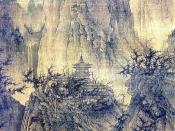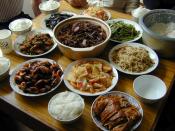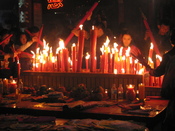Parents wake up very early in the morning to cook a vegetarian breakfast in order to thank the Goddess or their ancestors for the past year and to express their desire to have a better year in the future. After the food is ready, they wake their children up, wash up, and put on new clothes especially clothes with red color. Then everyone eats a piece of candy to start filling the next year with sugar, love, sweetness, and happiness. After the kids are ready, they greet their parents and everyone in the house with good morning, Happy New Years and Gung Hay Fat Choy.
Chinatown is bedecked with lights and almost overnight, roadside stalls sprout pussy willows, mandarin trees and plum blossoms while food stores work feverishly to produce loads of festive goodies. New Year as a whole the is perhaps the grandest, noisiest festival in the Chinese calendar.
New Year Eve and New Year Day are celebrated as a family, a time of reunion and thanksgiving. The celebration is traditionally highlighted with a religious ceremony given in honor of Heaven and Earth, the gods of the household and the ancestors, usually our great grand parents . It's utmost significance to go through the customary Chinese New Years traditions: house cleaning, decorations, lots of food, and more for their celebration.
Jung 2
Chinese New Year is a time of special celebration and joy; therefore many old customs and performances are incorporated into the festival celebrations and competitions held on Chinese New Years. The most common of these are perhaps the dragon dance and lion dance.
The dragon dance was already a popular activity by the Sung Dynasty(960-1279A.D.), and has continued to be so up to the present. The dragon mask and boy used in the dance may be gold,


